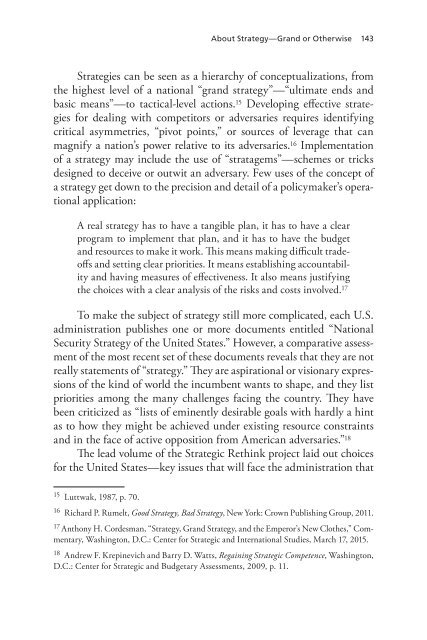Create successful ePaper yourself
Turn your PDF publications into a flip-book with our unique Google optimized e-Paper software.
About Strategy—Grand or Otherwise 143<br />
Strategies can be seen as a hierarchy of conceptualizations, from<br />
the highest level of a national “grand strategy”—“ultimate ends and<br />
basic means”—to tactical-level actions. 15 Developing effective strategies<br />
for dealing with competitors or adversaries requires identifying<br />
critical asymmetries, “pivot points,” or sources of leverage that can<br />
magnify a nation’s power relative to its adversaries. 16 Implementation<br />
of a strategy may include the use of “stratagems”—schemes or tricks<br />
designed to deceive or outwit an adversary. Few uses of the concept of<br />
a strategy get down to the precision and detail of a policymaker’s operational<br />
application:<br />
A real strategy has to have a tangible plan, it has to have a clear<br />
program to implement that plan, and it has to have the budget<br />
and resources to make it work. This means making difficult tradeoffs<br />
and setting clear priorities. It means establishing accountability<br />
and having measures of effectiveness. It also means justifying<br />
the choices with a clear analysis of the risks and costs involved. 17<br />
To make the subject of strategy still more complicated, each U.S.<br />
administration publishes one or more documents entitled “National<br />
Security Strategy of the United States.” However, a comparative assessment<br />
of the most recent set of these documents reveals that they are not<br />
really statements of “strategy.” They are aspirational or visionary expressions<br />
of the kind of world the incumbent wants to shape, and they list<br />
priorities among the many challenges facing the country. They have<br />
been criticized as “lists of eminently desirable goals with hardly a hint<br />
as to how they might be achieved under existing resource constraints<br />
and in the face of active opposition from American adversaries.” 18<br />
The lead volume of the Strategic Rethink project laid out choices<br />
for the United States—key issues that will face the administration that<br />
15 Luttwak, 1987, p. 70.<br />
16 Richard P. Rumelt, Good Strategy, Bad Strategy, New York: Crown Publishing Group, 2011.<br />
17 Anthony H. Cordesman, “Strategy, Grand Strategy, and the Emperor’s New Clothes,” Commentary,<br />
Washington, D.C.: Center for Strategic and International Studies, March 17, 2015.<br />
18 Andrew F. Krepinevich and Barry D. Watts, Regaining Strategic Competence, Washington,<br />
D.C.: Center for Strategic and Budgetary Assessments, 2009, p. 11.




